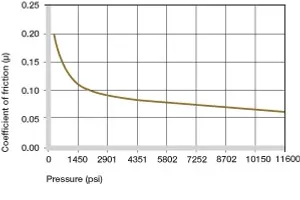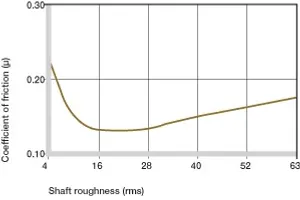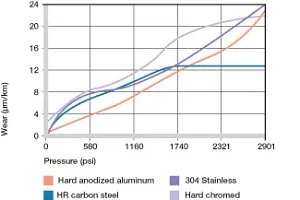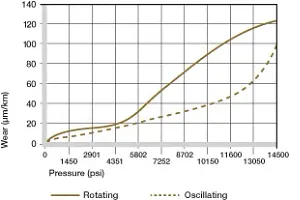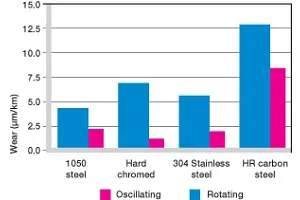Change Language :
iglide® Z - Material data
Materials table
| General features | Unit | iglide® Z | Test method |
|---|---|---|---|
| Density | g/cm³ | 1.40 | |
| Color | Brown | ||
| Max. humidity absorption at 73° F/50% R. H. | Wt.-% | 0.3 | DIN 53495 |
| Max. water absorption | Wt.-% | 1.1 | |
| Coefficient of surface friction, dynamic, against steel | µ | 0.06-0.14 | |
| p x v value, max. (dry) | psi x fpm | 24,000 | |
| Mechanical properties | |||
| Modulus of elasticity | psi | 348,100 | DIN 53457 |
| Tensile strength at 68° F | psi | 13,775 | DIN 53452 |
| Compressive strength | psi | 9,425 | |
| Permissible static surface pressure (68° F) | psi | 21,750 | |
| Shore D hardness | 81 | DIN 53505 | |
| Physical and thermal properties | |||
| Max. long-term application temperature | °F | 482 | |
| Max. short-term application temperature | °F | 590 | |
| Min. application temperature | °F | -148 | |
| Thermal conductivity | [W/m x K] | 0.62 | ASTM C 177 |
| Coefficient of thermal expansion (at 73° F) | [K-^1 x 10^-5 ] | 4 | DIN 53752 |
| Electrical properties | |||
| Specific volume resistance | Ωcm | > 10^11 | DIN IEC 93 |
| Surface resistance | Ω | > 10^11 | DIN 53482 |
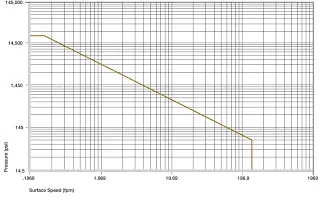
Permitted p x v values
For iglide® Z plastic bushings with 0.039 inches wall thickness in dry operation against a steel shaft, at 68° F, installed in a steel housing.
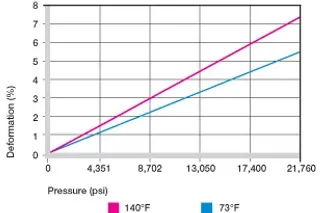
Deformation under load and temperatures
Compressive Strength
iglide® Z is a high-temperature material for bushings suitable for applications with extremely high specific loads. With radial loads between 7,250 psi and 14,500 psi, there is no other iglide® material with better wear resistance in dry operation. The graph shows the elastic deformation of iglide® Z with radial loads. Under the maximum recommended surface pressure of 21750 psi, the deformation amounts to about 5.5%.
Permitted surface speeds
iglide® Z is suitable for both medium and - due to the high heat resistance - high speeds. The maximum values stated in the table can be attained only with minimum pressure loads. The specified values show the speed at which due to friction an increase in temperature up to the long-term permitted value can occur.
| fpm | Rotating | Oscillating | Linear |
|---|---|---|---|
| Constant | 295 | 216 | 984 |
| Short-term | 689 | 492 | 1181 |

Maximum recommended surface pressure dependent on the temperature
Temperatures
The short-term permitted maximum temperature amounts to 590° F and thus attains the maximum heat resistance of any iglide® material.
With increasing temperatures, the compressive strength of iglide® Z plastic bushings decreases. The graph clarifies this connection.
The temperatures prevailing in the bushing system also have an influence on the bushing wear. The wear rises with increasing temperatures.
The graph shows that in the iglide® Z plastic bushing the wear just doubles if the temperature rises to 302° F. Under high temperatures, iglide® Z is also the most wear-resistant material in dry operation.
Temperature limits
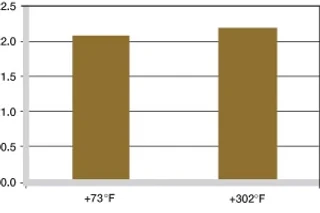
| iglide® Z | Application temperature |
|---|---|
| Lower | - 148 °F |
| Upper, long-term | + 482 °F |
| Upper, short-term | + 590 °F |
| Additional axial securing | + 293 °F |
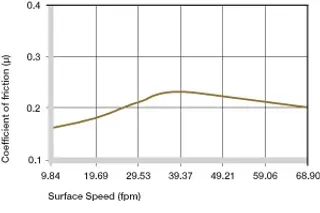
Coefficients of friction dependent on the surface speed, p = 108 psi
Friction and wear
The coefficient of friction alters only slightly like the wear resistance with increasing load.
Friction and wear also depend to a high degree on the reverse partner. Very smooth shafts increase the coefficient of both friction and wear. iglide® Z proves to be relatively insensitive with regard to the shaft surface. The best suited is a smoothed surface with an average roughness range of 16 - 32 rms.
Coefficients of friction for iglide® Z against steel (Ra = 1 µm, 50 HRC)
| iglide® Z | Dry | Fat | Oil | Water |
|---|---|---|---|---|
| Coefficients of friction µ | 0.06 - 0.14 | 0.09 | 0.04 | 0.04 |
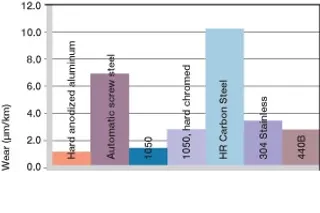
Wear, rotating application with different shaft materials, load p = 108 psi, v = 98 fpm
Shaft materials
The diagrams show, in the lower load range, wear rates that are by all means similar to that of other indicated iglide® materials. In the upper range in contrast, iglide® Z outclasses all other materials in wear resistance.Provided a 1050 hard chromed shaft is used, the wear at 6525 psi is still only 15 µm/km.
With low loads, the iglide® Z plastic bushings wear out less in pivoting applications than in rotating applications. 303 Stainless Steel and hard-chromed shafts stand out in particular here. The value 0.5 µm/km shows 303 Stainless provides the lowest wear in oscillating movements at 280 psi. With higher loads hard-chromed shafts outperform 303 Stainless. However even at 14,500 psi, iglide® Z attains excellent coefficients of wear.
Please contact us in case the shaft material scheduled by you is not included in this diagram.
Important tolerances for iglide® Z plastic bushings according to ISO 3547-1 after the press-fit.
iglide® Z plastic bushings are standard bushings for shafts with h-tolerance (recommended minimum h9).
After the installation in a housing bore with H7 tolerance, the inner diameter of the bushing automatically adjusts to F10 tolerance.
| Diameter d1 [mm] | Shaft h9 [mm] | iglide® Z F10 [mm] | |
|---|---|---|---|
| Up to 0.019685 | 0 - 0.0009842 | +0.0002362 | + 0.0018110 |
| > 0.118 to 0.236 | 0 - 0.0011811 | +0.0003937 | + 0.0022835 |
| > 0.236 to 0.394 | 0 - 0.0014173 | +0.0005118 | + 0.0027953 |
| > 0.394 to 0.709 | 0 - 0.0016929 | +0.0006299 | + 0.0033858 |
| > 0.709 to 1.181 | 0 - 0.0020472 | +0.0007874 | + 0.0040945 |
| > 1.181 to 1.969 | 0 - 0.0024409 | +0.0009843 | + 0.0049213 |
Material resistance
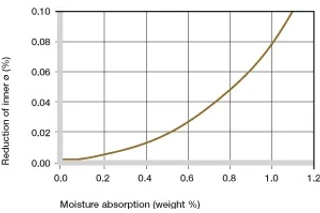
Chemical resistance
iglide® Z plastic bushings have a good resistance against chemicals. They possess an excellent resistance to organic solvents, fuels, oils and greases. The material is only partially resistant to weak acids. The moisture absorption of iglide® Z plastic bushings amounts to about 0.3% in standard climatic conditions. The saturation limit in water is 1.1%.
Radioactive rays
iglide® Z plastic bushings are radiation resistant up to a radioactive intensity of 1 x 105 Gy.
UV-resistant
With UV radiation, the tribological properties (wear) of the iglide® Z plastic bushings drop by about 50%
Vacuum
In application in vacuum, the potentially existent moisture content is degassed. For this reason only the dry iglide® Z plastic bushings are suitable for vacuum.
Electrical properties
iglide® Z plastic bushings are electrically insulating.
| Medium | Resistance |
|---|---|
| Alcohol | 0 |
| Hydrocarbons, chlorinated | + |
| Greases, oils, without additives | + |
| Fuels | + |
| Weak acids | + |
| Strong acids | - |
| Weak alkaline | + |
| Strong alkaline | - |
| + resistant 0 conditionally resistant - non-resistant |
Electrical properties
| Specific volume resistance | Surface resistance |
|---|---|
| > 10^11 Ωcm | > 10^11 Ω |
